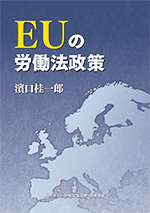JILPT Research Eye
The Role of “Agreements” in EU Labor Law Policy
July 6, 2017
(Originally published on March 10, 2017 in Japanese)

Research Director General
On January 27th this year, I published EU no rōdōhō seisaku (EU labor law policy) through JILPT. This is a complete reworking of EU rōdōhō no keisei (Formation of EU labor law), published in the days of the Japan Institute of Labor in 1998. It adopts a historical viewpoint in describing nearly every topic raised as legal policy – both those that have borne fruit as directives and those that have yet to do so – across the whole spectrum of EU labor law, based on various published materials, media reports and so on. Running to more than 500 pages in quite fine print, the book introduces detailed EU legal policy on issues currently topical in Japan, namely equal pay for equal work and regulation of long working hours; on a broader level, however, it is full of knowledge and information that will be of use for people with an interest in labor law policy in the UK, France, Germany and other EU member states.
This time, I would like to very briefly discuss “The Role of ‘Agreements’ in EU Labor Law Policy,” an important topic in the book. What makes the strongest impression on anyone who researches EU labor law is the solid presence of corporatism in the system of labor legislation. The constitutional norm known as the Treaty on the Functioning of the European Union (TFEU) provides for involvement and initiatives by labor and management and is positioned as an expression of democratic principles in lawmaking. The origin of this lies in the complete failure of labor-related bills under the Thatcher government in the 1980s. In a bid to overturn this, Jacques Delors, the EC President at the time, created a system of labor legislation based on the 1991 Social Chapter of Maastricht Treaty on European Union. Under the system thus established, all EU labor legislation first had to be referred to labor relations bodies at EU level for consultation. As the consulted bodies could negotiate by themselves, the ball would then be in their court, and if an EU level labor agreement were concluded as a result of the negotiation, that would then go straight into EU labor law with binding effect upon EU member states, in the form of a directive. A number of directives on important policies were created in this way, including some that are even well known in Japan; the directive on parental leave, the directive on part-time work and the directive on fixed-term work are but a few examples. Besides these, working hour regulations in specific sectors such as ships’ crews, civil aviation, multinational railways and inland water transport have also been created in the form of directives taken straight from industry specific labor agreements. Though more detail on this gradual progression can be found in my book, this is still the basic principle of EU labor legislation today. More than anything, “agreements” in EU law are positioned as the most important stage for deciding content when enacting such laws.
However, anyone who has studied labor law, as it has developed in the various countries, must feel that “agreements” are first and foremost negotiated spontaneously by labor relations bodies, then are concluded as the result of that. For sure, there is a generally binding system of agreements in countries on the European continent; there is also a widely practiced system whereby labor agreements that are inherently private contracts between labor and management are also applied to outsiders through the involvement of state authority. From the outset, however, these are not positioned as a stage in the process of legislation.
In fact, the tone of provisions in TFEU also echoes this pattern. TFEU Article 155 provides as follows:
- Should management and labor so desire, the dialogue between them at Union level may lead to contractual relations, including agreements.
- Agreements concluded at Union level shall be implemented either in accordance with the procedures and practices specific to management and labor and the Member States or, in matters covered by Article 153, at the joint request of the signatory parties, by a Council decision on a proposal from the Commission.
This is a framework whereby, firstly, there are normal labor agreements, i.e. agreements implemented “in accordance with the procedures and practices specific to management and labor and the Member States,” and of these, there are some that are implemented “at the joint request of the signatory parties, by a Council decision,” i.e. those that become EU law. In the 1990s, however, priority was placed on using these routes to legislate draft directives that could not be passed during the Thatcher years. As a result, autonomous agreements did not appear in their original form.
This all changed in the 2000s, when “soft” EU laws started to be created on themes subject to consultation from the European Commission. Rather than adopting the form of EU laws stipulated by TFEU, these were implemented by labor relations bodies themselves, specifically through such bodies in each country belonging to an EU level body. Examples include the teleworking agreement, the workplace stress agreement and the agreement on harassment and violence at work.
Trends in recent years have become even more complex and baffling in nature, however. One of these is the situation whereby labor relations bodies autonomously start EU level negotiations and conclude labor agreements without consultation from the European Commission. It is not made specifically clear in the wording whether the “agreements” provided in paragraph 1 of TFEU Article 155 are limited to those premised upon and concluded as a result of Article 154 (consultation with management and labor), or whether they refer to agreements concluded at EU level as separate from Article 154. Such agreements that are started and concluded autonomously have been tending to increase at industry-specific level in recent years; some have gathered particular attention, such as the agreement on minimum requirements for professional footballers.
No problems are caused as long as these autonomous agreements are also implemented autonomously by labor relations bodies themselves. The problem comes when an autonomously concluded agreement is brought to the European Commission with a request to implement it as a directive based on paragraph 2 of TFEU Article 155. In 2012, though at first favorably inclined toward an agreement on health and safety in the hairdressing sector concluded between Coiffure EU and the trade union UNI Europa Hair & Beauty, the European Commission changed its mind after criticism from the governments of member states, and refused to make it legally binding as a directive.
Incidentally, a certain kind of “agreement” at EU level has been increasing on a different dimension from EU level agreements that have developed as macro policy measures in this way. Based on the European Works Council Directive enacted in 1994, the number of agreements concluded between multinational corporations and their labor organizations has already passed 250, the main theme being restructuring. However, there is currently no legal provision of any kind concerning these “agreements.” With the exception of TFEU Article 155 above, there is nothing that could be described as EU law on labor agreements.
Since the 2000s, therefore, the European Commission has been attempting to turn multinational corporation agreements into law, while commissioning research groups and holding expert meetings. What is interesting is the draft bill announced by the European Trade Union Confederation (ETUC, an EU level labor relations body) in 2016. Discussion by the European Commission mainly assumes corporate agreements in which a European Works Council (an organization of employees’ representatives) is one of the main protagonists. In the ETUC proposal, however, a major point of divergence is the assumption that the party on the labor side must always be a labor union, or specifically a European level industry-specific organization.
Thus, in EU labor law policy in recent years, “agreements” have continued to raise problems that touch on the very foundations of labor legislation.
Published Information

EU no rodoho seisaku (EU labor law policy) (in Japanese)
- Publication Date: January 27, 2017
- ISBN: 978-4-538-41161-3
- JILPT Research Eye > Back Number > The Role of “Agreements” in EU Labor Law Policy

